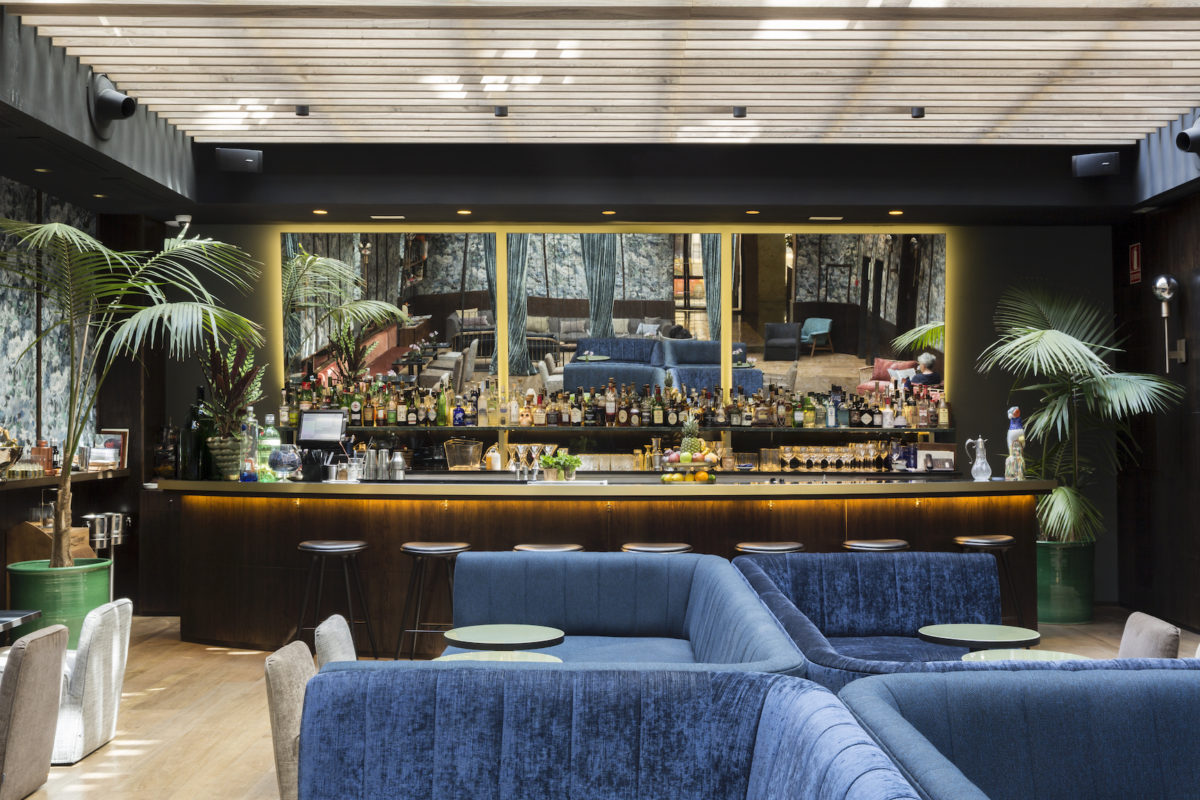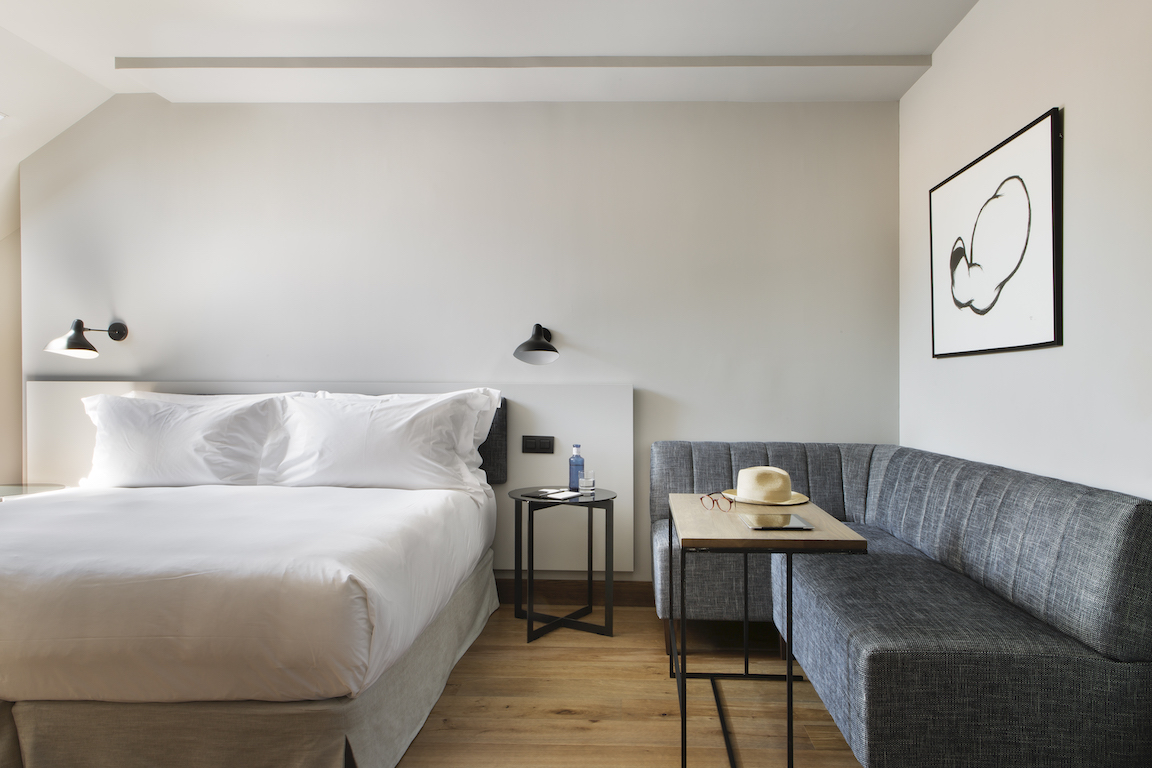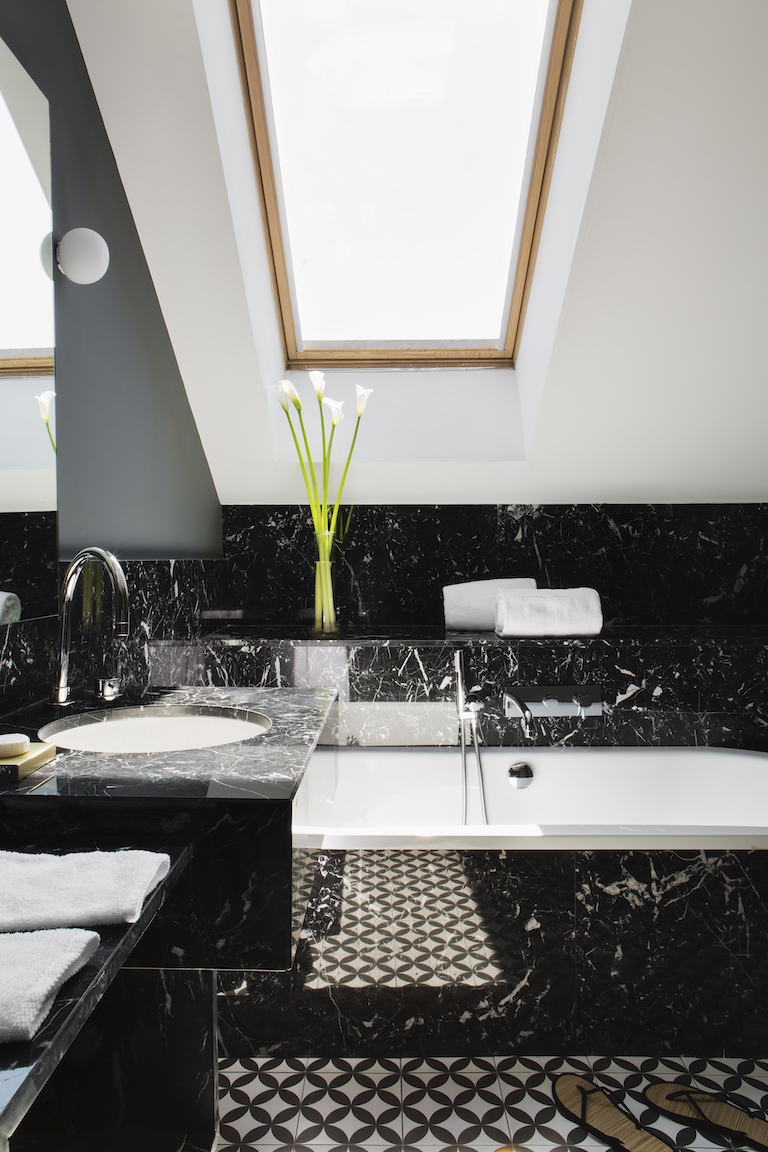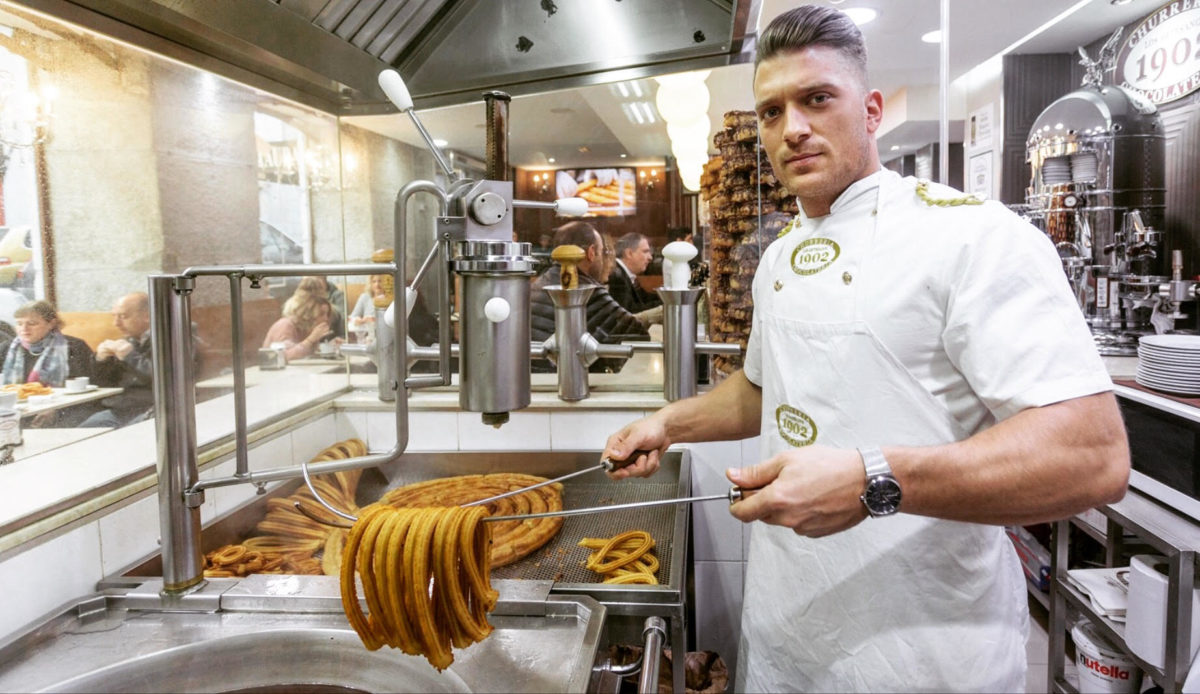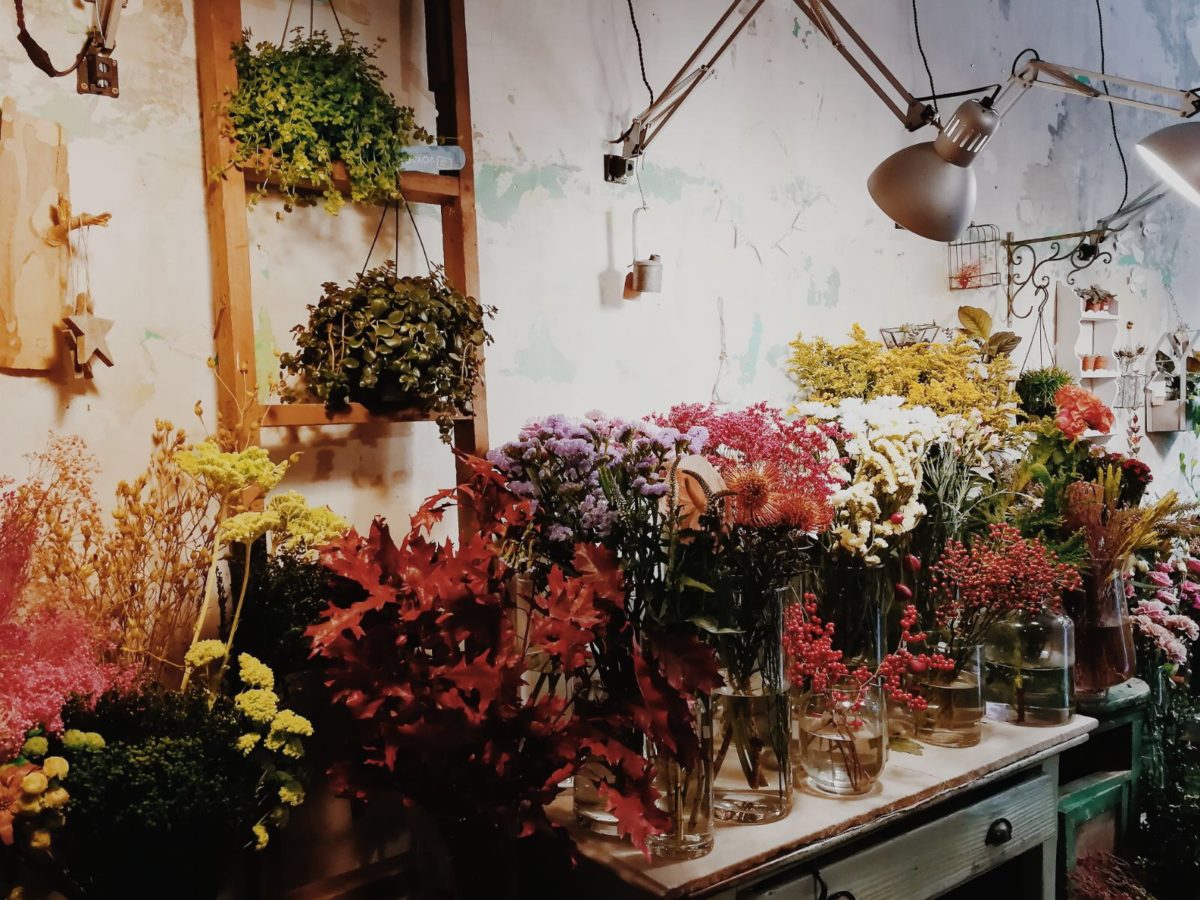Madrid is at the center of Spain in more ways that one. The capital city is rooted in tradition but has a forward-thinking approach and a wealth of culture that embodies the rich, unhurried Spanish spirit—not to mention Madrid’s amazing food scene (for which we have provided a full-service restaurant and tapas guide below).
You could spend endless hours wandering Madrid’s vibrant neighborhoods, exploring tapas taverns, and petit boutiques. And while you won’t want to miss the world-class galleries at the Museo Nacional del Prado and the Museo Reina Sofía, we have some additional ideas for under-the-radar sightseeing.
Stay
Set in the upscale (and quieter than most) Salamanca neighborhood, Tótem Madrid offers sophistication without pretension. The hotel occupies a restored 19th-century aristocratic residence, so it’s high on charm with architectural details like a sweeping wooden staircase and charismatic attic rooms with sloped ceilings. Rooms are painted moody blue with marble bathrooms, minibars stocked with local goodies, and Juliet balconies overlooking the leafy boulevards below. The sexy ground-floor bar serves creative, well-priced cocktails with a seasonal flair, and their La Parrilla del Pimiento Verde restaurant features a menu of rich Basque cuisine.
The easternmost section of Madrid’s Gran Vía is its oldest. Built in the first decade of the 1900s, this leg of the thoroughfare was once the city’s banking core. And with a name nodding to that financial history, Vincci the Mint hotel has a prime location on the Gran Vía, and one of the best rooftops in the city. A pale green entryway welcomes you to a lounge-like lobby that reads more quirky cocktail bar than hotel check-in desk. The modern rooms feature mid-century decor and herringbone wood floors. But you’ll want to take the elevator to the eighth floor for the pièce de résistance: a spacious terrace with panoramic views and a mint-hued drink truck.
In a city with over 300 days of sunshine per year and generally high average temperatures, there’s nothing not to love about a rooftop plunge pool, and Dear Hotel delivers. Its 14th-floor terrace holds the glassed-in pool and a plant-filled restaurant, commanding 360-views of the Royal Palace, the opera house, Gran Vía, and beyond. Inside, the airy rooms have streamlined Scandi style. Special occasion? An upper-level suite with a private terrace is well worth the splurge.
Eat and Drink
Blink and you might miss the best coffee shop in Madrid. With a nondescript entrance tucked into a wall of Calle de la Palma in the Malasaña district, Toma specializes in expertly pulled shots and house-roasted beans for drinks that are a cut above your average cafe con leche. Their cold brew with tonic is especially refreshing. The shabby-chic space is also a prime spot for a quick breakfast. The petit menu offers inventive toasts, tasty baked goods, and brunch bowls that all rotate at the whim of the kitchen.
Markets have always been central to Spanish culture, and their modern iterations offer more than produce and fresh fish. The Mercado de San Ildefonso is one such space, a multilevel food hall with restaurant stalls, bars, and communal terraces. Cuisines range from Mexican tacos to vegan fare, a jamón y queso vendor and Venezuelan arepas, plus plenty of tapas and traditional Spanish options. The market is lively around mealtimes, so you’ll want to stake out your space. For more food hall fun, check out the upscale Platea Madrid, the packed Mercado de San Miguel, and the sizable Mercado San Anton.
If dining on a stainless steel butcher’s table in a stark meat locker that feels right out of an episode of Dexter sounds up your alley, run, don’t walk, to Sala de Despiece. Even if you’re just a fan of inventive, beautifully executed tapas, you’ll want to make a reservation here, too. The restaurant’s name translates to “cutting room,” and the menu focuses on the best cuts of everything from choice meats, seafood, and vegetables priced by weight or unit. Ingredients seem simple, but presentation is everything. Servers torch, roll, and pour each dish tableside. Standouts include the “Rolex,” a strip of pancetta folded over an egg yolk atop a medallion of foie gras and truffle gelee; an enormous peeled tomato with fried basil, olive oil, and salt; and the chuletón cenital strip steak that you eat with your hands. Book a seat at the 12-person communal table, or try your luck at the buzzy tapas bar.
Helmed by master mixologist Diego Cabrera, acclaimed cocktail bar Salmon Guru is, above all else, really, really fun. The decor is eclectic, bordering on gaudy, but in a way that somehow works with loud neon lights, zebra-striped curtains, and furniture that fuses a grungy ’90s club with a ’50s tiki setup. Once you’ve picked from the extensive, equally eclectic cocktail menu, the show begins with drinks that smoke, blaze, and bubble served in off-the-wall glassware. And if you’re unsure, you’ll find helpful bartenders more than willing to whip up something special or recommend a favorite. Arrive early to avoid the line; they don’t take reservations.
One could write an entire guidebook of the places in Madrid that Ernest Hemingway was said to frequent. But while many bars and restaurants claim to be Papa’s favorite, only one gets special mention in both The Sun Also Rises and Death in the Afternoon. The same suckling pig he mentions remains a specialty at Restaurante Sobrino de Botín today, as it was long before Hemingway graced the tables. Founded in 1725, Casa Botín is on record as the oldest restaurant in the world and has an oven that’s been continuously burning all that time. The dishes are undeniably traditional, for a memorable meal that tastes of history.
Chocolate con Churros
If Madrid had an official indulgence, chocolate con churros would win hands down. Madrileños line up at institutions like Chocolatería San Ginés and Los Artesanos 1902 for plates of the fried dough ropes with a soft center and crispy exterior dusted in sugar. The accompanying cup of hot chocolate for dipping is more like warm pudding than a sippable beverage. The best part? There’s no wrong time to partake in this treat, as evidenced by the long opening times (San Ginés is open 24 hours). Breakfast churros? Definitely. Mid-afternoon snack? For sure. Post-clubbing munchies? Absolutely. You’ll find some straight from the fryer whenever the craving hits.
The Ultimate Tapas Crawl
The restaurants in the immediate vicinity of the major museums tend to have more misses than hits, but head a few blocks further to Taberna El Sur for a tasty, local experience. After a day of art overload, start your tapas tour here with a pitcher of sangria (some of the best in the city). For food, many dishes are available as individual tapas or larger, shareable raciónes. Standouts from the menu of well-executed, traditional fare include the extra tender carrillada de cerdo (pork cheeks) and the gambones (shrimp) in sizzling garlic sauce.
La Venencia
Not much has changed in La Venencia since it first opened in the 1930s. The tobacco-tinged watering hole has been serving sherry from behind the wooden bar since the Spanish Civil War—and with bartenders that look like they could have been there for just as long. Your only beverage options are sherry, sherry, and more sherry (called Jerez in Spanish). Specifically: Manzanilla, Fino, Oloroso, Amontillado, and Palo Cortado. Spanish sherry has a nutty flavor and can range from extra dry to syrupy sweet. A glass at La Venencia is cheap, so go ahead and try a few. As for tapas, the options are simple: buttery olives, Manchego cheese, or a selection of charcuterie.
Casa Revuelta
Sharpen your elbows for the quintessential tapas experience at Casa Revuelta. This small bar is consistently packed with locals and visitors alike, so you’ll need to be gently agressive to make your way to the bar. It’s worth it once you get there, though, for authentic dishes like fried bacalao (a flakey cod in a crispy batter, the most famous in the city) and albóndigas (meatballs) in tomato sauce. Feeling adventurous? Other specialties include stewed tripe and squid in an ink sauce. Wash it all down in a caña, a small glass of draft beer perfect for this bar grub.
If you’ve had your fill of jamón y queso at this point, La Concha delivers inventive bites alongside traditional ones. The tiny tavern first opened in 1996 and only gets better every year. You’ll find dishes like duck with orange slices on toast, oxtail cannelloni, and anchovies in pesto sauce. It’s also one of the few tapas taverns with a dedicated gluten-free menu. Perhaps the best deal, La Concha participates in a dying tradition of including a free tapa (of their choice) when you order a drink.
Where to Shop
Looking through the windows into the veritable garden inside, it’s easy to assume that Adhoc Flores peddles nothing but peonies and lush arrangements, but step through the door and an enchanting boutique emerges. Among buckets of fresh-cut and dried flowers (it smells divine, by the way), the shop has racks of ethereal womenswear by independent designers, plus a section of vintage clothing. There’s also a gorgeous selection of locally made jewelry and accessories—from dainty pendants to distressed leather pouches—and a number of thoughtfully curated home goods.
Just north of the Gran Vía, the neighborhood of Malasaña is home to stylish eateries, hip tattoo parlors, vintage emporiums, and trendy boutiques. You could spend days popping in and out of every housewares showroom and gift store—or you could one-stop shop at El Moderno Concept Store. The bi-level space specializes in well-designed, often playful home accessories, small furniture, art, jewelry, kitchenware, and more. It’s the perfect spot for decor inspiration and souvenirs made by local craftsmen—a ceramic planter or a handmade notebook, perhaps?—and houseplant lovers will feel right at home.
Underrated Museums
Born in Valencia, Spanish Impressionist painter Joaquín Sorolla y Bastida spent the second half of his life in Madrid, eventually settling into a home in the city’s Chamberí neighborhood where he lived until his death in 1923. Since then, the property has been converted into the Museo Sorolla, housing the largest collection of his work, which often features dreamy landscapes, sunlit seaside scenes, and expressive portraits. A visit to the museum is a unique opportunity to tour a turn-of-the-century aristocratic home and garden while also getting to know Sorolla’s work up close. Don’t miss Strolling Along the Seashore, a moving scene of two elegant women sauntering by the sea.
National Archaeological Museum
Having undergone a six-year renovation that wrapped up in 2014, the National Archaeological Museum has a well-organized collection that traces the pre-history of the Iberian peninsula through the Roman era, the Middle Ages, and 19th century. Visited by more school groups than tourists, the generally uncrowded museum is a welcome respite from the throngs at the Prado or the packed Puerta del Sol. Unearth Madrid’s past through Ancient Roman mosaics, a 2,600-year-old mausoleum, and Visigothic crowns. One of the most important pieces is the Lady of Elche, an extremely well-preserved sculpture from the 4th century BC depicting a woman with an elaborate headdress. There are several collections from outside of Spain, including those dedicated to Ancient Greece and Egypt. All of the galleries are well signed in English.
With over 160,000 pieces from the Middle Ages through today, the Museo del Traje (Costume Museum) is a fashion and history lover’s dream. Spaniards are notoriously well dressed, and a walk through this museum’s uncrowded galleries proves that crisp suits and ornate frocks aren’t just a recent phenomenon. The permanent collection’s halls chronologically trace the evolution of bridal gowns, regional dress, menswear, and more. There’s also a gallery dedicated to Basque-born Cristóbal Balenciaga and his namesake fashion house. Don’t miss the collection dedicated to traveling clothes to see how yours compare.


